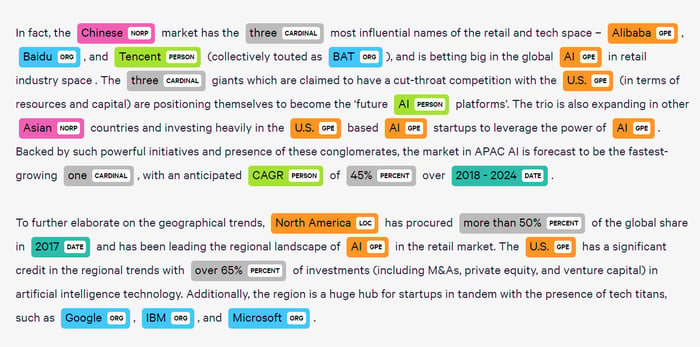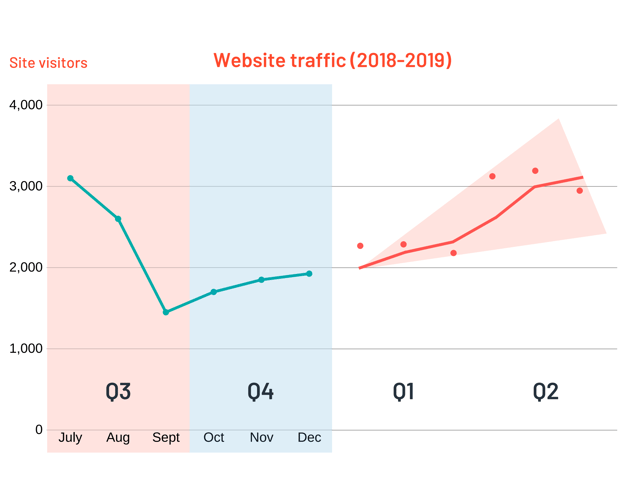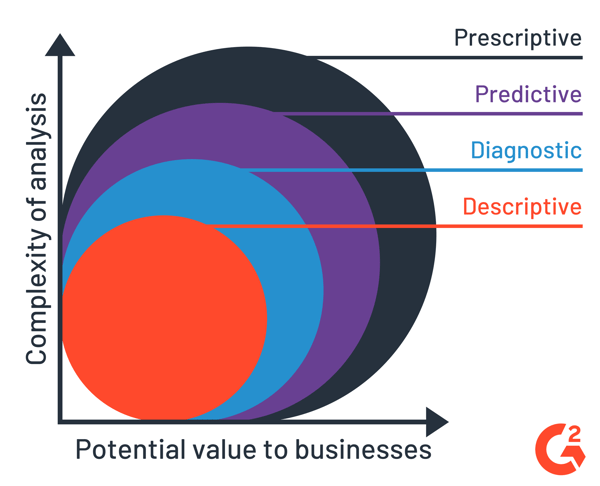There are many types of analytics today, each showing a different picture to help drive change and address business problems.
Some analytics are retrospective, like descriptive and diagnostic analytics. These analyses pinpoint “what” happened and “why” it may have happened, and are great for general reporting.
More traditional analytics, like business analytics, is important for establishing KPIs and other metrics for business intelligence.
Then there’s more advanced analytics:
What is advanced analytics?
Advanced analytics is an umbrella term encompassing predictive analytics, prescriptive analytics, data mining, and other analytics using high-level data science methods.
Why is advanced analytics important?
Advanced analytics provide deeper, more advanced insight into patterns, trends, and themes that may be hidden within data. This allows businesses to understand their customers on a deeper level, predict future outcomes, reduce risk, and more.
In this guide, we’ll briefly cover the methods that make up advanced analytics, and why each is important for deconstructing big data.
Topic 1: Data mining
Data mining is defined as “knowledge discovery within databases,” and it can be considered a true backbone of advanced analytics today.
The purpose of data mining is to sift through large datasets to uncover patterns, trends, and other hidden insights that may not be clearly visible. This is done using machine learning and statistics. Think of data mining as a deep-dive into data analysis.
There are a variety of data mining methods. Some of the most common include:
- Clustering analysis – Grouping large datasets based on similarities within the data. Some insurance companies use clustering for identifying groups of policyholders with high average claims.
- Anomaly detection – Also known as outlier detection, this method looks for data points that are rare and outside an established group or average. Anomaly detection is often used to identify fraudulent behaviors in the finance industry.
- Association rule mining – Looking at how one variable relates to another. For example, if event A occurs, then event B is likely to follow. Some e-commerce sites may apply this to predict your next purchase.
- Regression analysis – Looking at the effect one variable has on many others. In the healthcare industry, regression may be used to examine how body mass index (BMI) affects other aspects of health.
Text mining
Another type of data mining, called text mining, is an advanced method of extracting high-quality information from text data on apps and the Web. It is sometimes referred to as text analysis.
With so much text everywhere, it’s impossible to analyze without the help of intelligent automated systems. Text analysis software first retrieves information, then applies natural language processing (NLP) to break down sentence structures, recognize named entities and common phrases, examines conferencing, and much more.
Here’s an example of a paragraph broken down based by named features like people, businesses, geographical locations, landmarks, well-known abbreviations, and more.


Topic 2: Predictive analytics
One of the most prominent types of advanced analytics today is predictive analytics.
This type of analytics takes “what happened” and “why it happened” a step further by analyzing historical data to predict future outcomes. This is done through a variety of statistical techniques like data mining, machine learning, and predictive modeling.
Predictive analytics mines data from systems like CRM, ERP, marketing automation stacks, and other databases. The results are then visualized in a way so key business users can interpret them. Below is a basic example of what these visualizations may look like:
 Predictive analytics software is important for gaining a competitive advantage, understanding a variety of customer interests, finding new business opportunities, reducing costs and risks, and most importantly, addressing problems before they occur.
Predictive analytics software is important for gaining a competitive advantage, understanding a variety of customer interests, finding new business opportunities, reducing costs and risks, and most importantly, addressing problems before they occur.

There are many industry examples of predictive analytics today. Healthcare is able to more accurately predict negative health events using analytics. Human Resources (HR) uses analytics to identify pain points and productivity spikes for predicting the future performance of employees.
Even when you turn on the television and watch your local weatherperson’s seven-day forecast, those models were built with the help of predictive analytics looking into historical weather patterns. Pretty neat, huh?
Topic 3: Prescriptive analytics
Predictive analytics allows us to understand what is likely to happen next, while prescriptive analytics provides calculated next steps to take. Out of all the types of data analytics, it is perhaps the most actionable.

Prescriptive analyses are complex in the world of data science, often using both structured and unstructured data to form its insights. Applied statistics, deep learning, computer vision, and other advanced methods are used in prescriptive analytics.
Because of the high barrier to entry, prescriptive analytics is not commonly used by many businesses today. These type of analytics can be quite expensive to generate and require the assistance of data science teams – a field that’s drastically under-employed at the moment. Until prescriptive analytics become more accessible, predictive analytics will continue to be the standard.
Topic 4: Big data analytics
There is so much data generated today, it’s outpacing our ability to capture and analyze it, that’s why big data analytics has become so prominent over recent years.
Most of big data is actually unstructured, meaning it cannot be processed and analyzed using conventional methods. This data is things like images, videos, audio files, social media posts, and other multimedia.
Big data analytics software and a variety of big data technologies are available to deconstruct and make sense of big data.
The finance industry currently works with quantitative models – using big data – to predict enter/exit trade decisions and minimize risk. Large retailers use big data to forecast demand for certain products. Tech-focused education analyzes big data to explore new, more tailored learning options for students.

| Related Content: You can read more about the many ways big data is being applied today in our roundup of big data examples. |
Advanced analytics, advanced outcomes
Advanced analytics are important because they’ll help more businesses draw advanced insights from their data – insights they may have not even been aware of.
Through the use of data mining, machine learning, statistical modeling, and other methods, advanced analytics is making industries everywhere more competitive.
Interested in learning more about data analytics without all the technical jargon? Our beginner’s guide should give you a baseline knowledge.

 by Mara Calvello
by Mara Calvello
 by Devin Pickell
by Devin Pickell
 by Mara Calvello
by Mara Calvello